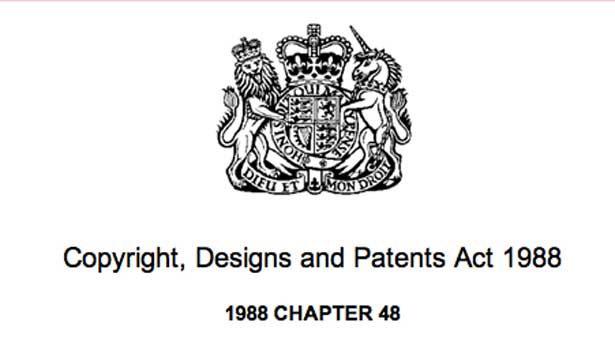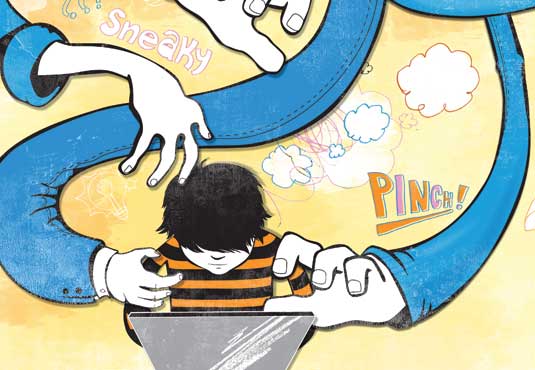The designer's guide to copyright
Copyright affects everybody who works in design, but many don't understand the fundamentals. We explain the ins and outs of not staying on the right side of the law.
With thousands upon thousands of pages of brand-spanking-new content being published in print every day, let alone online, there is a growing challenge for designers to ensure that they are not falling foul of copyright legislation.
Copyright law has become an even bigger minefield with the growth of the internet. Lots of misconceptions exist around the issue, which has led to a blurring of what is and isn’t considered theft, but there are steps which designers can take to ensure that they can continue to deliver the goods for a pushy client or boss without the risk of infringement - whether accidental or not.
US vs UK law

Copyright legislation in the UK is covered under the Copyright, Designs and Patents Act (1988). This act affords protection to the owners and creators of:
- literary, dramatic and musical works (these must be recorded in a permanent form)
- artistic works (which could include photographs, computer code and software)
- sound recordings and films
- broadcasts
- published editions
Any work that could be considered as one or more of the above is subject to copyright protection and as a result, you should ask the rights holder for permission to use a ‘significant part’ of their work.
The definition of ‘significant’ varies depending on the work and is not based on quantity but instead, is a judgement on whether the ‘essence’ of an idea has been taken. For more guidance, you can read the act here.

In the US the Copyright Act of 1976 rewarded a set of exclusive rights to all authors and artists; these rights included the right to make and sell copies of your work, the right to create derivative works, and the right to perform or display your work in public. Works which are covered by the Act include:
- Literary, musical and dramatic work
- Pantomimes and choreographic work
- Pictoral, graphic and sculptural work
- Audiovisual work, sound recordings and compilations
- Derivative work
- Architectural work
The Digital Millennium Copyright Act of 1998 also covers work produced online. Copyright is granted automatically upon the creation of the work, although many choose to register their work with the Copyright Office anyway, in order to expediate the process should they be the victim of copyright infringement. As in the UK, permission must be granted by the copyright holder to use, display, distribute, sell, perform or reproduce the work.
Get the Creative Bloq Newsletter
Daily design news, reviews, how-tos and more, as picked by the editors.
The US copyright law does not cover ideas, theories or facts used to create these works, which remain in the public domain. The same idea, as long as it is expressed differently from the original work, can be used without breaching copyright law.
The Fair Dealing defence
In publishing, whether in print or online, it pays to know how you can justify something as fair dealing – because if you don’t, it might end up paying someone else as the result of suing you.
Fair dealing is a concept that allows you to use a portion of a copyrighted works for the purposes of research and private study (although these must be non-commercial), criticism, review and news reporting – provided that you reference the copyright owner.
So, as an example, using representations of a Dalek from Doctor Who to illustrate the changes in their design over the past 50 years could be done under the defence of fair dealing, as this is a critique and review, but using them as the villains in your very own sci-fi adventure is likely to raise some serious questions!
Differences in local laws

What may be acceptable in other countries may not be acceptable in others. There is a lot of confusion between UK and US legislation, with many believing that certain principles from across the pond also apply to the UK. For example, photography can be covered by 'fair use' in the US but the equivalent defence of 'fair dealing' in the UK does not apply to photographs. Similarly, the US makes provision for parody and satire material, yet no such provision is made in the UK.
Protect your own work
With all the care you take in making sure not to misrepresent you and your business using false or stolen information, wouldn’t it be frustrating to find that someone else was infringing upon your own intellectual property?
Depending on where you’re based, different laws apply to establish ownership and copyright on your work - an in-depth guide to protecting your own work can be found here.
Indemnity insurance
Of course, as in any area of business, accidents can happen - and so it would be of great benefit and peace of mind to ensure that you’re protected from any unfortunate instances which would arise during the course of business.
Professional indemnity insurance is an option which more and more creative enterprises are taking up. For a full explanation on what this involves, check out this simple guide here.
Illustrations: I Love Dust
Like this? Read these!
- Learn about design law and raise cash for charity
- How to write a business plan
- How to balance creativity with business needs
Have you been involved in a copyright dispute? Let us know in the comments box below!

Thank you for reading 5 articles this month* Join now for unlimited access
Enjoy your first month for just £1 / $1 / €1
*Read 5 free articles per month without a subscription

Join now for unlimited access
Try first month for just £1 / $1 / €1

The Creative Bloq team is made up of a group of art and design enthusiasts, and has changed and evolved since Creative Bloq began back in 2012. The current website team consists of eight full-time members of staff: Editor Georgia Coggan, Deputy Editor Rosie Hilder, Ecommerce Editor Beren Neale, Senior News Editor Daniel Piper, Editor, Digital Art and 3D Ian Dean, Tech Reviews Editor Erlingur Einarsson, Ecommerce Writer Beth Nicholls and Staff Writer Natalie Fear, as well as a roster of freelancers from around the world. The ImagineFX magazine team also pitch in, ensuring that content from leading digital art publication ImagineFX is represented on Creative Bloq.
